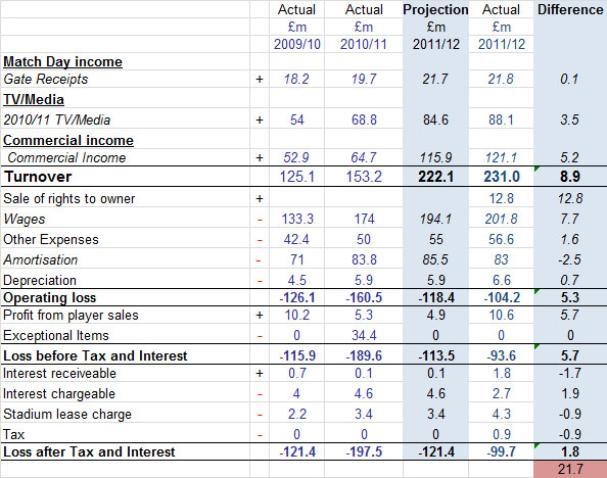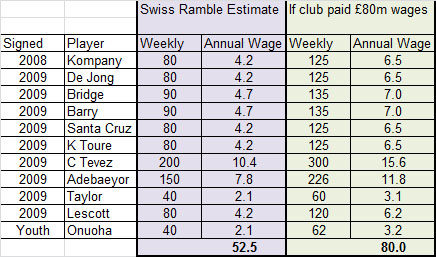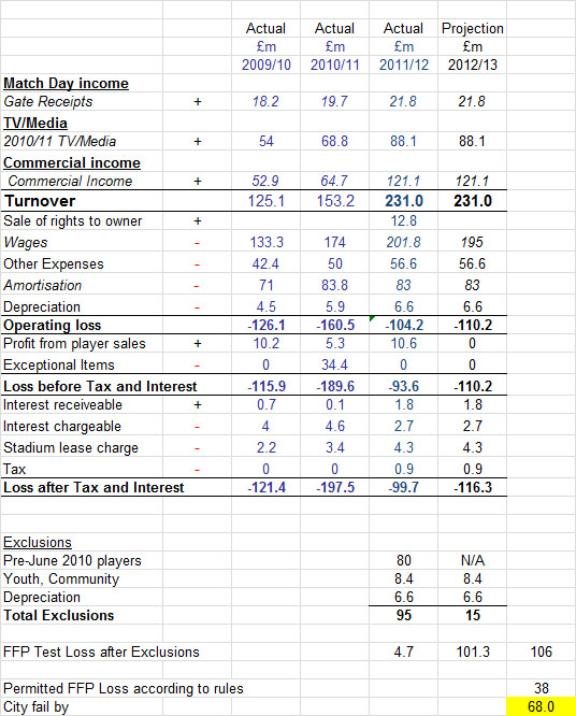Manchester City's 2011/12 accounts - the Devil is in the detail
Back in May, I published a projection on whether Manchester City were on track to meet the FFP criteria. Now that the club’s financial results for last season have been released, it seems a good time to revisit the original projection and look again at the club's FFP challenge.
On Friday, City officially announced a loss of £99.7m for the season 2011/12. Interestingly, many journalists were not impressed that the figures were released late on a Friday afternoon in an apparent, though fairly successful, attempt to minimise critical analysis of the information. Putting this issue aside, we can now look at the accuracy of my original projection and whether there are any 'oddities' hiding in the accounts (spoiler alert: there are several).
I have attached my original projection and added two new columns on the far right of the table below – ‘2011/12 Actual’ and the’ Difference’ (so we can see how far out I was).

The first thing to notice is the fact that my projection was out by £ 21.7.1m (figure in bottom right). City’s losses were £99.7m rather than the £121.4m that I projected. That seems like a lot – however, when you look at the detail, it was not as far away as it first appears.
I underestimated the uplift from TV and commercial income by £8.9m. These figures include the Commercial uplift from winning the title and the first appearance of the impact of the Etihad deal. City have never fully released the actual figures for the Etihad contract so there was always and element of estimation in the projection.
The biggest discrepancy relates to the item shows above as ‘sale of rights to owner’. This item is particularly interesting and has not been fully explained by the club. On page 114 of the report, the club advise:
“..the Company sold certain Design, Know-How and other Intellectual Property Rights to Abu Dhabi United Group and Investment & Development Limited for £12.8m.”
Quite what this figure actually represents is unclear and critics will suggest that City may have ‘sold’ something of little real value to the parent company in an attempt to artificially inflate income (and help the club meet the FFP rules). However, under the FFP rules ‘Related Party’ transactions have to be reviewed UEFA panel and this item may ultimately have to be adjusted downwards (potentially to zero). There may also be a further debate over this item and whether it is ‘relevant income’. The FFP rules permit clubs to include revenue received from football-related activities. The rules are somewhat vague but it is possible that this item would technically not be classified as ‘relevant income’ for the purposes of the FFP test. Understandably, I had not anticipated this item in my original projection and this was the main area of variance.
City’s wages increased by nearly £28m. I had been rather conservative and projected only a £20m increase.
Overall, if we exclude the £12.8m Related Party transaction, the original projection was a net £8.9m out. This figure equates to around 3.8% of Turnover and, all things considered, is a fairly pleasing result.
FFP Exclusions
As readers of this site will be aware, FFP rules allow for certain expenditure to be excluded from FFP calculations. These are:
- Wages for players signed before June 2010
- Depreciation of Fixed Assets
- Expenditure on youth and community activities
Again, late on Friday afternoon, City provided journalists with the figures for the exclusions, together with some helpful explanatory ‘spin’ (which was reproduced unchallenged and word-for-word by three news outlets).
City advised that Pre-June 2010 wages were £80m and Youth and community & Depreciation activities totalled £15m. Again, we should look at how these figures compare to my original projection:

My original projection and the Actual figure differ by £24.1m. The Youth and community development figures were always a ‘finger in the air’ estimate – however they appear to have been fairly close. The main discrepancy relates to the amount of wages City paid to players in 2011/12 on contracts signed before 1 June 2010. The FFP rules permit the wages for these long-standing players, paid during the 2011/12 season only, to be excluded from the FFP calculations (as long as the contract was not subsequently re-negotiated or extended). So why was there a £27m discrepancy between my calculations and the £80m figure released to the press on Friday? Who were the players involved and did City really pay £80m to these players on pre-June contracts?
In my original projection, I used Swiss Ramble’s figures for projected wages for the players on pre-June 2010 contracts (the pale blue columns). The columns on the right (pale green) show how much the wages would need to be for City to have paid them £80m last season (as the club claim).

It seems extremely unlikely that the club would have paid £80m in wages to these players – the weekly salaries are simply too high. The £52.5m figure looks much closer to reality. We should also consider that the top-earner Tevez had his salary withheld for an extended period during the season. Although the club paid players a bonus for winning the title, the bonus for the entire 24-man playing squad equated to only £6.2m.
On the face of it, City’s claim to have paid these players £80m simply doesn’t seem at all credible.
Player Contract Write-down
In the previous year’s accounts (i.e. those released 12months ago, relating to 2010/11), the club reported one-off ‘exceptional items’ totalling £34.4m. Of this figure, £29m related to ‘impairment of player registrations’ – i.e. the one-off write-down of players who the club considered had no resale value. This write-down was performed immediately before the start of the first FFP Monitoring Period and had the effect of reducing the players Book Value (and Amortisation) to zero.
Swiss Ramble believes Santa Cruz and Bridge are included in this figure. Although this ‘write-down’ is perfectly acceptable for accounting purposes, it is not permitted under the FFP rules (a player has to be amortised evenly over the life of the contract, i.e. until the contract ceases to exist). Under FFP rules, Santa Cruz and Bridge should be amortised at the combined rate of £6.5m a season (or £13m over the two-year Monitoring Period). However City’s recently-released accounts do not contain this expense. It is interesting to speculate whether City will go out of their way to make the UEFA Licensing panel aware of this treatment and volunteer the fact that an additional £13m needs to be added to their expenses when the Break Even test is carried out.
City Projection
Now the accounts for last season are available, we can produce a much more informed projection of whether they are on course to meet the FFP test.

Based on the assumptions outlined below, City would fail the FFP test by around £68m. This projection carries a few health-warnings and assumes there are no player sales or purchases during the forthcoming transfer window.
Assumptions used
In producing the above, I have assumed City finish second in the Premier League (this seems sensible as City are currently second-favourites with bookmakers to win the title). I have assumed Turnover is flat (there will be fewer games owing to the early exit from all UEFA competitions; the TV Merit payments will be lower and a sizeable portion of last season’s Commercial Income uplift resulted from winning the Premier League plus the new Etihad deal). Although City made a net spend of £39.4m during the summer (page 114 of the Annual Report), wages or amortisation don’t appear to me to have changed. City also don’t appear to repeated the £10.6m profit on player sales that they achieved last season (indeed, depending on the treatment of Adebeyor, it is possible the club will actually report a loss on player sales of around £7m). I have assumed a reduction in wages compared to last season to reflect the fact that a bonus for winning the PL would not be paid should the team finish second. For the purposes of the projection, I have used City’s somewhat implausible £80m figure for the exclusion relating to wages for players on pre-June 2010 contracts. I have assumed that the club don’t repeat the sale of ‘Intellectual property’ for £12.8m next season.
If the above assumptions were to prove correct, the loss after Tax and Interest would actually increase next year compared to this (£116m compared to the £97.7m recently reported). Although it is fairly close, if this were to happen this would be significant as only if losses are trending downwards could the club make use of the provision in Annex XI which allows the club to exclude the pre-June 2010 wages (£80m). In this scenario, City would actually miss the FFP target by around £148m)!
Given the above figures, it is interesting to speculate on what City could pull out of the bag to enable them to hit the FFP targets. So far, their critics would probably accuse City of using the following techniques:
· Significantly increased sponsorship from a potentially Related Party (Etihad)
· Write-down of players contracts outside of the FFP rules
· Seemingly inflated pre-June 2011 wages
· Sale of Intellectual Property to club owners.
Given the club’s stated confidence in their ability to meet the FFP criteria, it will be interesting to see what other techniques the club uses to get themselves over the line.
blog comments powered by Disqus
